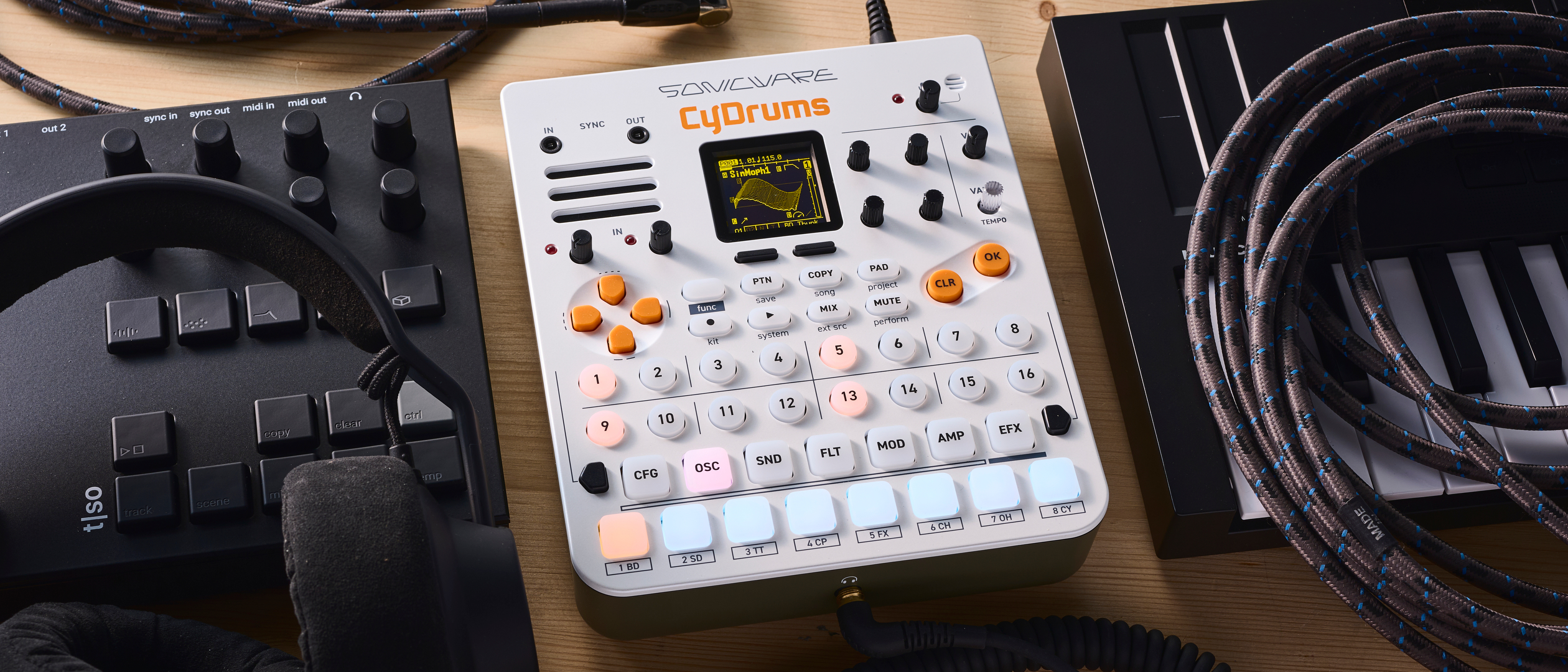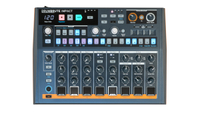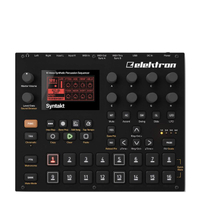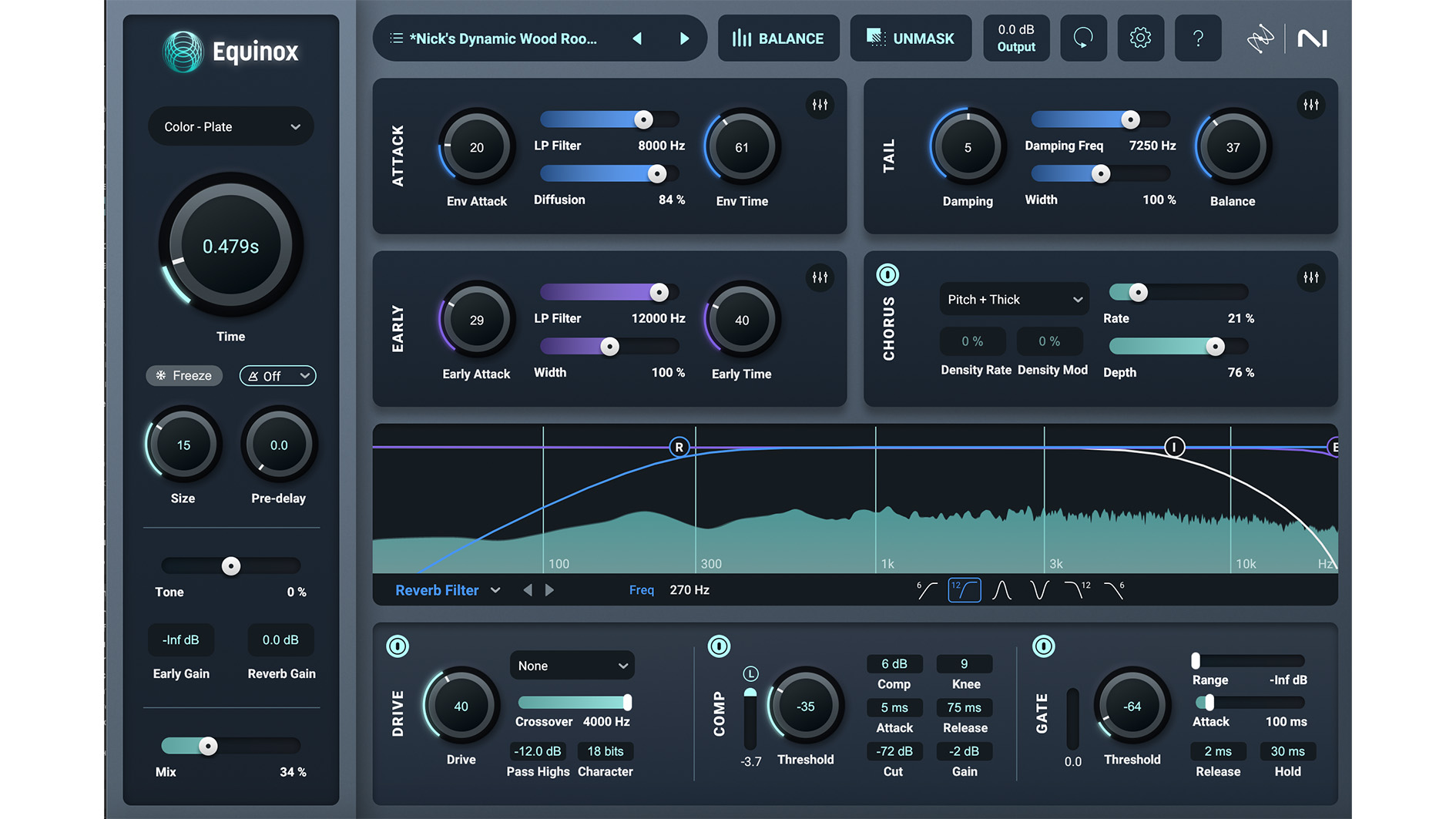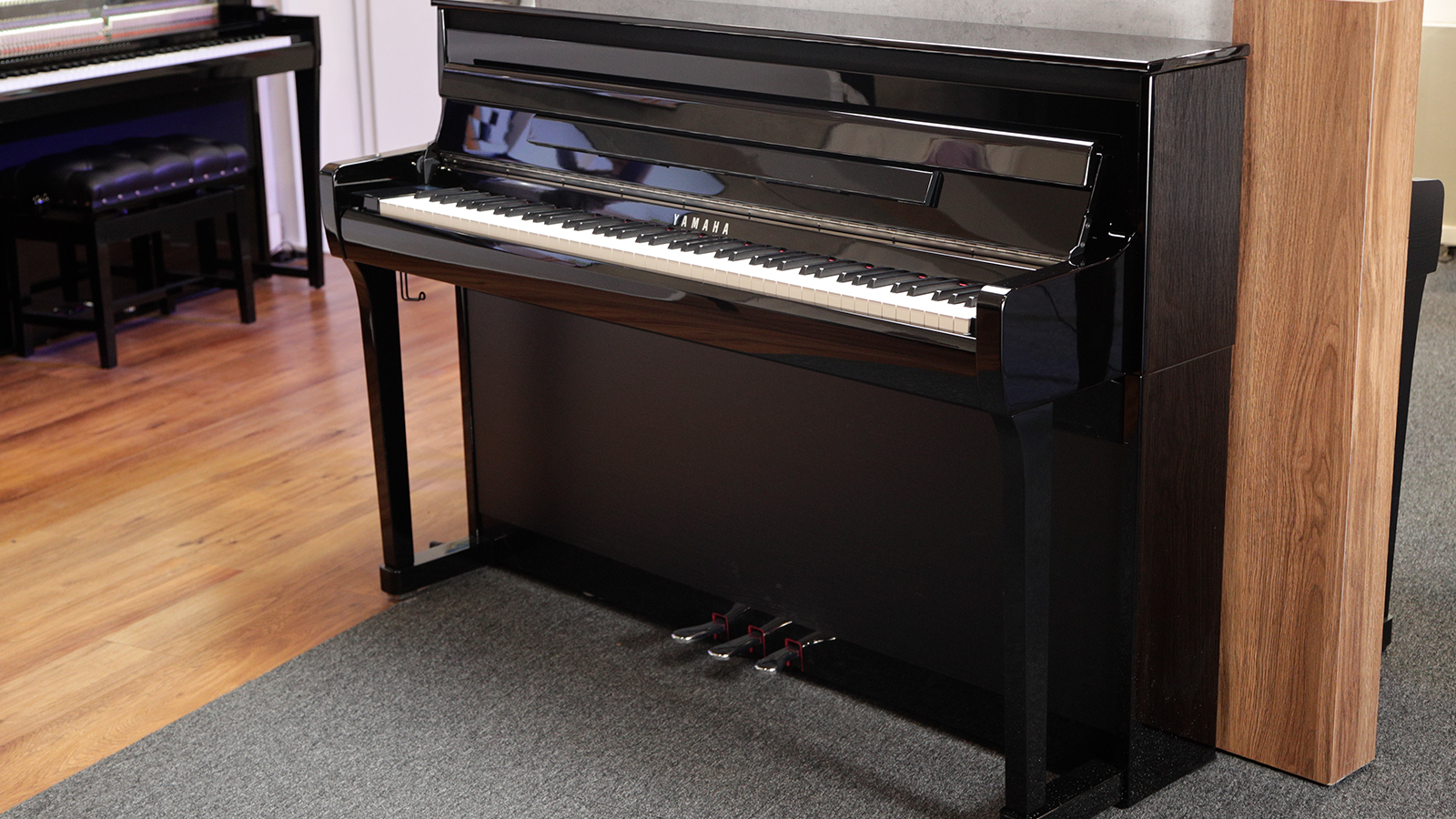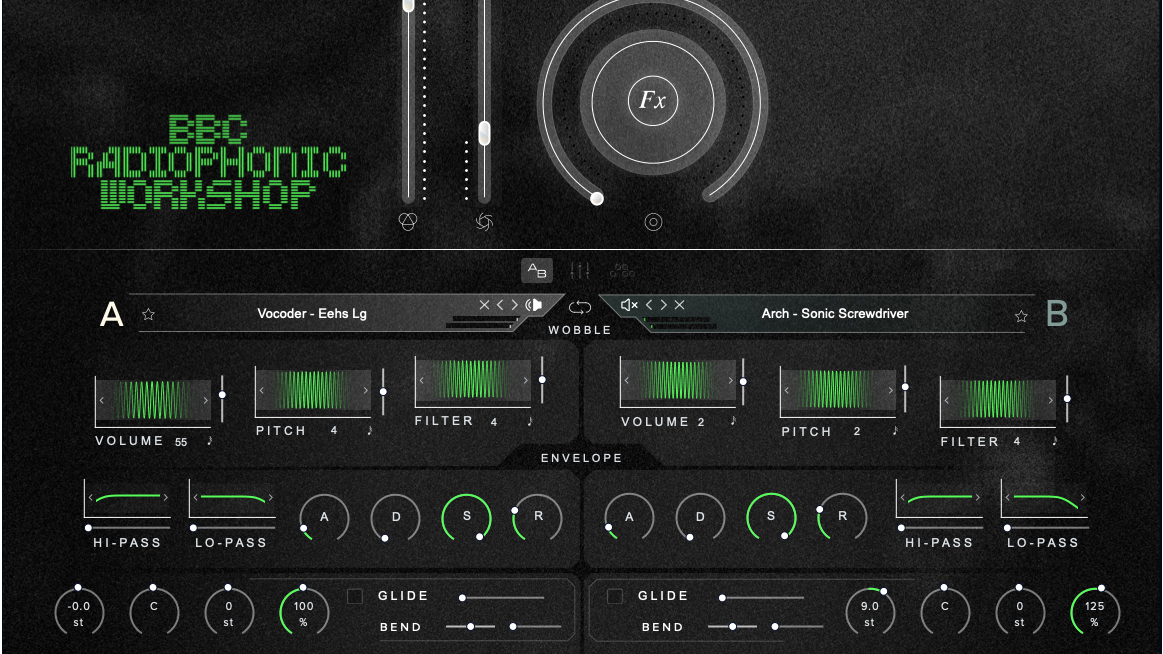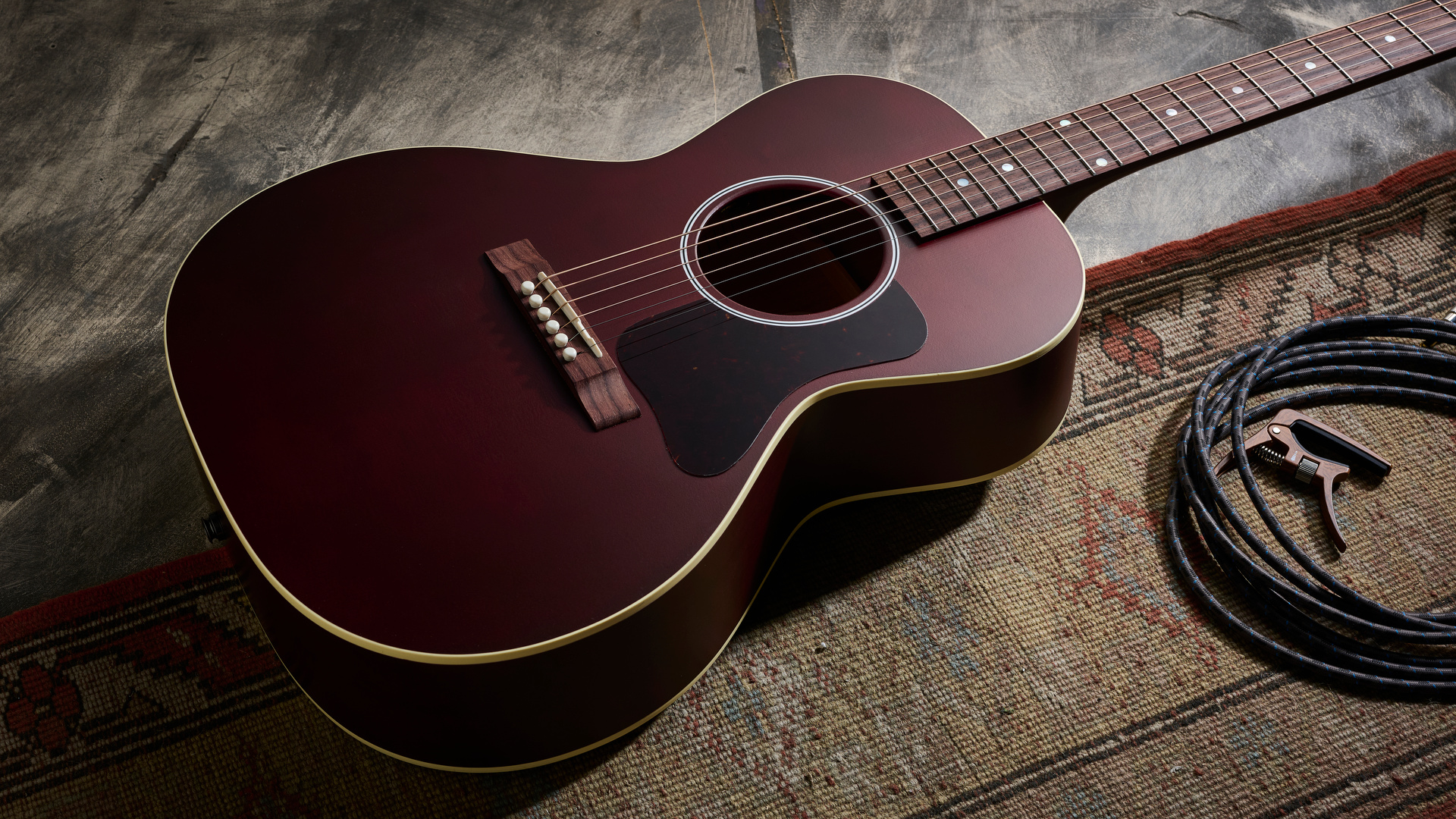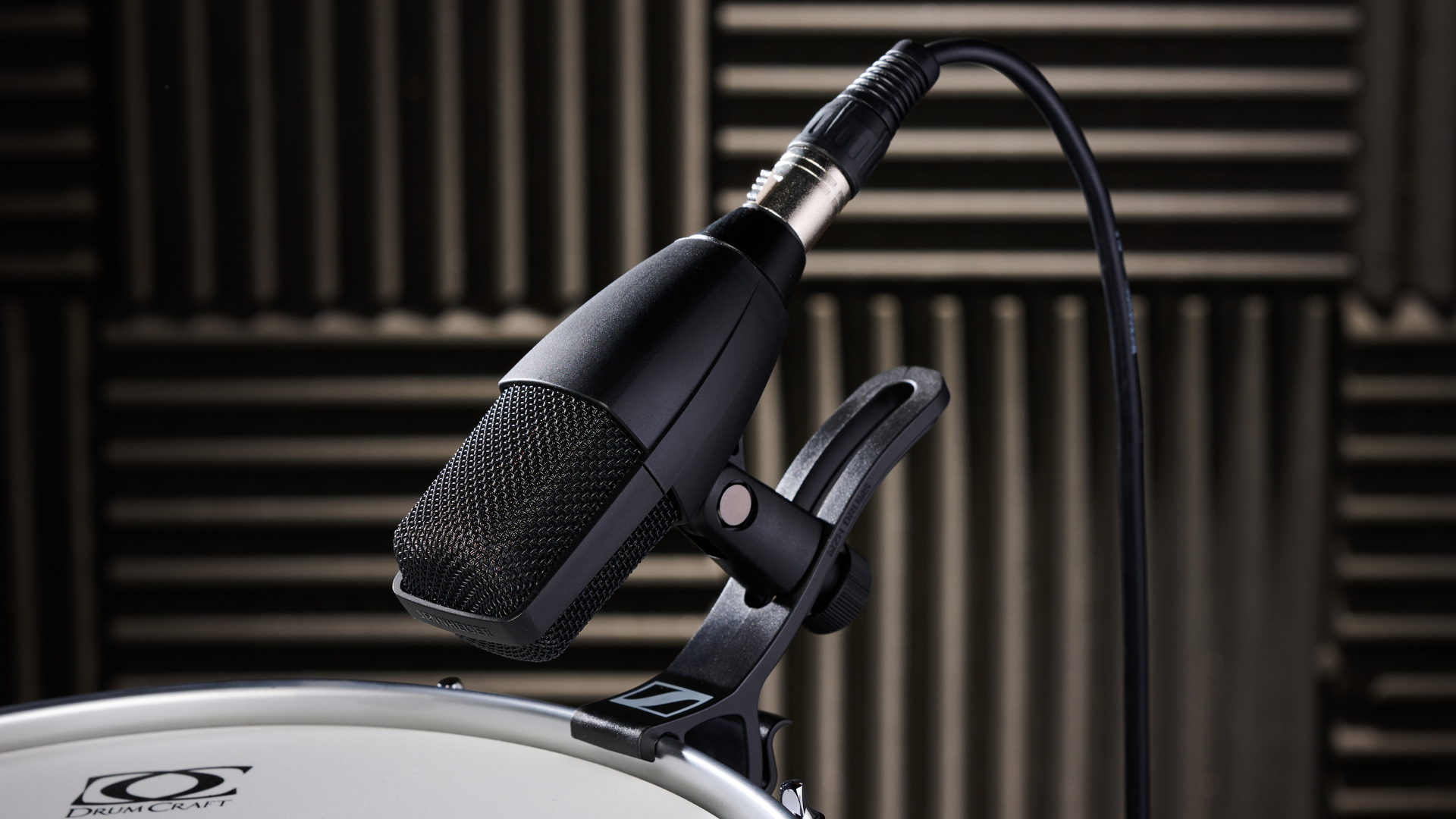MusicRadar Verdict
CyDrums is a hardware drum synth that dares to create different, dynamic and extreme beats and we love it for doing just that. There are cheaper options but it’s still great value considering its depth and sonic flexibility.
Pros
- +
Great, flexible and evolving sounds.
- +
In-depth synthesis if you want it.
- +
Useful effects and modulation.
Cons
- -
Steep initial learning curve.
- -
More extreme than standard beats.
- -
There are cheaper alternatives.
MusicRadar's got your back
What is it?
Sonicware is a relatively new company that has chosen an arguably tough route to market: music production hardware with a difference, and at an affordable price. Its Liven range – which includes Ambient O, 8bit Warps, and Lofi-12 – perhaps sums up its target audience: those after something a little off-kilter or genre-specific, and products that the big oil tankers like Roland and Yamaha would never attempt a turning for, let alone sell for just $239.
CyDrums is more of the same, although pricier at $499 (currently $399). It’s an impressively spec’d drum machine that doesn’t deliver XOX sounds – unless you delve and tweak (which it encourages you to do) – but does deliver beats, blips, and melodic monophonic sounds all based on a dual wavetable engine, and aimed at glitch, leftfield EDM and genres yet to be invented. It’s doing different beats in hardware, for not much more than a top-end piece of software, and it’s doing it rather well.
The CyDrums form factor is more in line with the company’s SmplTrek and Lofi-12 XT units; that is oblong/portrait-shaped with a lot of parameters on hand, rather than the more keys and landscape-orientated Liven range. We suspect that SonicWare sticks to a couple of main designs and operating systems to keep costs down across its ranges and we’re all for that approach.
However, this does mean CyDrums has features that are seemingly yet to be implemented. Its mic and audio ins have ‘sampling’ written all over them, but the unit just functions as an effects box thus far, so you can’t add wavetables nor samples to its engine, although an expansion slot does let you load and save externally. Sonicware says of these inputs, “They only serve as inputs for instruments or vocals during streaming (with reverb applied). In future updates, we have plans to make them usable for sound design and beat-making.”
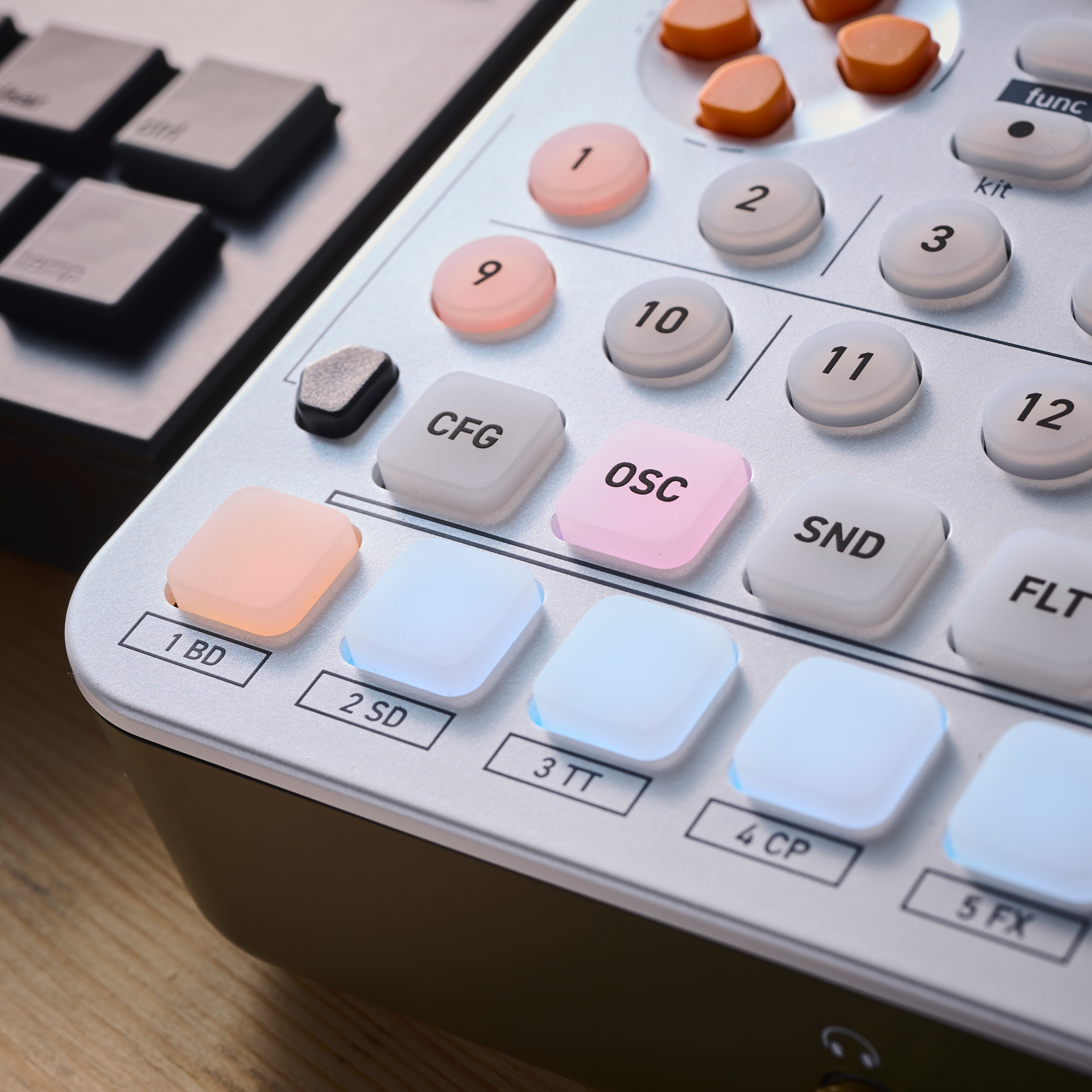
In terms of the main event, CyDrums has eight tracks of sequenced beats and melodic tones, each with 22 parameter setups to tweak. There are eight pads for each of the tracks and seven mode pads above these open up menus and sub-menus to access different options, including the sound for each track, and filter, oscillator, modulation, and effect options among others.
There are a very decent 550 sounds on offer, 256 effects patches but only nine preset kits, which is slightly surprising, but there are 128 locations to create more, and that really is CyDrums’ ‘thing'’; it wants you to take the onboard wavetable sounds, layer a couple together and tweak them into something crazy and create your own kits, and this you will do as it is pretty easy.
Use the onboard kits or your own to create patterns, which create songs within projects. With Pad mode allowing you to select a melodic sound, bass for example, across more than an octave of notes, you could sequence complete 8-track songs with CyDrums, pushing that drum machine remit way past its definition. Add the fact that those inputs make CyDrums an audio interface and effects box too, and it’s already looking like a bit of a winner, but how does it sound and how do we get there?
Pricing
- Full price: $499
- Currently on offer at: $399
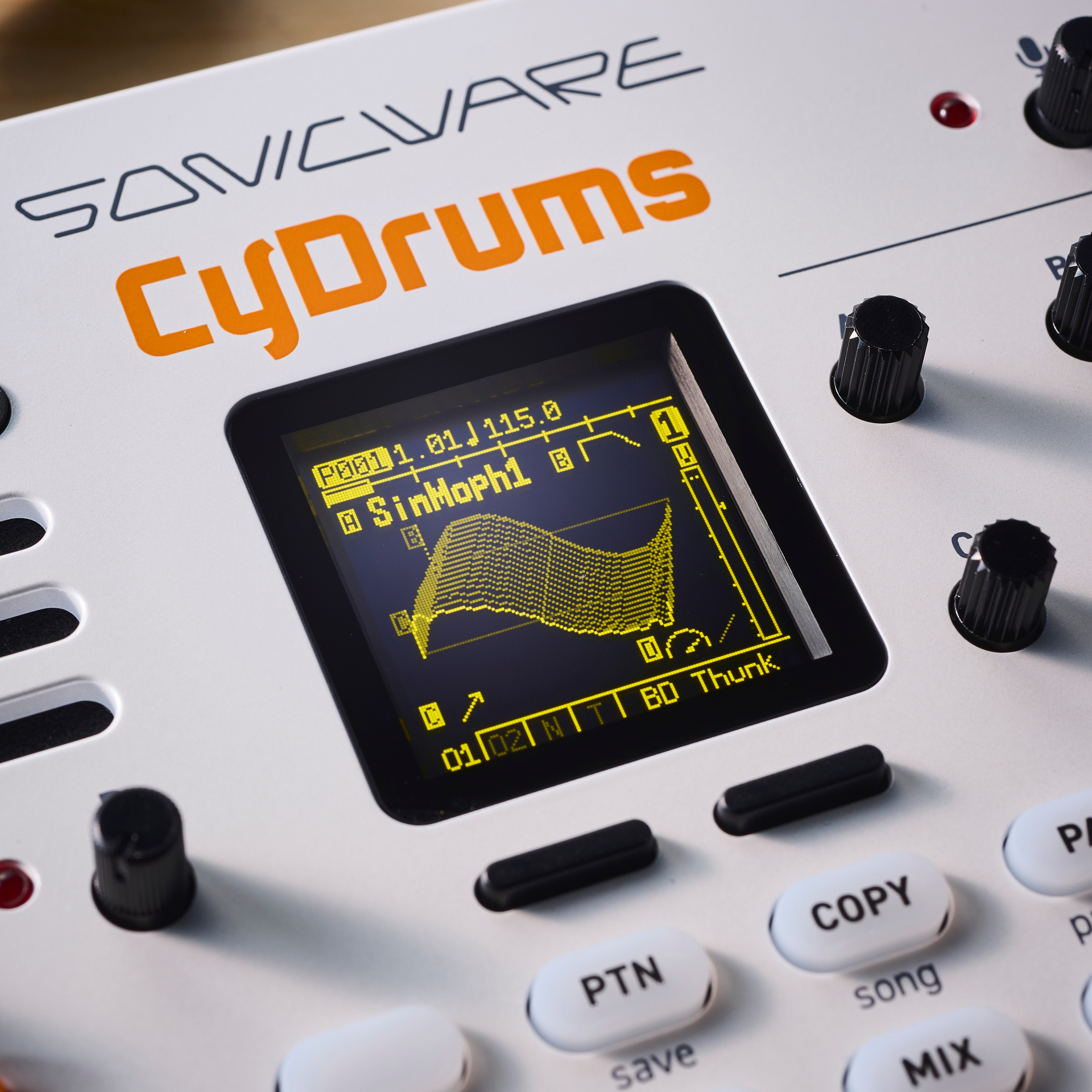
Performance
The CyDrums screen is key to all of this functionality and displays a wide range of info including pattern/song/step position, tempo, battery level, USB connectivity, track number, and sound/wavetable type, plus a whole host of other parameters depending on which mode you are in.
To get your beats going, it’s simply a matter of selecting one of the eight tracks, a sound for it (in Snd mode), and highlighting where you want it played by choosing from the 16 pad buttons on the cycling sequencer. You can also list all of the sounds available – 550 from 1,024 locations – by pressing the A button and navigating with the cursors.
You then create different patterns (of up to 128 steps), chaining them together for songs (with up to 99 patterns) which let you copy, paste, edit, and select patterns and step durations. There are also probability and random options for pattern creation which ups the creative side of CyDrums no end. Finally, there’s the ‘project’ which is the largest structure type and can include up to 128 patterns and 16 songs.
So far so ‘drum machine/sequencer’. The real fun with CyDrums starts with the hands-on tweaking where you can easily change a sound per channel and many other real-time parameters. Tweak the pitch – the screen indicates which control does this, which is rotary C in this instance – or change the envelope release (D). More envelope settings can be changed in Amp mode with its ADSR parameters, while the EFX mode gives you access to five effects routing options, each with two effects, reverb and master effects.

Again, controlling levels here is indicated by the A, B, C, and D screen icons referencing the main rotaries, and pressing each of these gives you access to the different effects on offer – 22 each for the two effects blocks and five master effects. These effects do sound incredibly dramatic when dialled to the full, stretching the onboard speaker to its limits, so we’d advise using phones or your main speakers here.
Other hands-on options include a fully-formed filter section with six types and a filter envelope, plus a dedicated Mod mode with two each of velocity and aftertouch modulators, and a modulation envelope that can all be applied to around 68 different parameters, including all of those wavetable options – very decent synthesis flexibility for a drum machine!
Another great hands-on feature is the Performance mode where you can introduce tape speed and stuttering effects, randomise steps, change pattern lengths, and alter track release times, just to add yet more variation, but without destroying the original patterns.
Finally, going even deeper, you can go into Osc mode and select from 64 wavetables and a noise oscillator and edit wavetable scan speeds, loops, directions, and much more. Really this is a fully-featured synth with more than you might ever wish for to experiment with, and as much depth as you dare dive into. Use it as a drum machine, yes by all means, but there’s a vast world to explore beneath the easy beats.

Verdict
CyDrums is an excellent, if slightly niche drum machine with some flexible functionality taking it into effects/interface territory. Channel any external audio via USB or the external audio ins and use the onboard effects. We particularly wanted to use CyDrums sync’d to our DAW with the audio monitored through it and mixed with the beats we were creating. After about half an hour, we had a pattern of bass and beats that very quickly became the backbone to an old set of ambient loops we’d been fiddling with for months, resulting in a track that – we think, anyway – could easily have been released on any Berlin label in the early 2000s.
CyDrums’ main plus point, though, is that it encourages sonic experimentation, eschewing the ‘normal’ beats you get on so many other drum machines – and in most DAWs – in favour of hands-on tweaking options and extreme sounds. The depth on offer can make for a steep initial learning curve, and some features don’t always do as you might expect – we occasionally found ourselves editing the wrong track parts, for example. But if you need to liven up your rhythms – so maybe it should have been in the ‘Liven’ range after all – CyDrums will deliver all the bangs for not so many bucks and all the blips and beeps you need. Do you dare ditch those ‘normal’ beats in favour of hands-on tweaking and extreme sounds? Of course you do.
Hands-on demos
SONICWARE
Alternatives
Incredibly, the original version of this brute is nearly a decade old but this update is still pumping out varied beats for a great price.
Read the full Arturia DrumBrute Impact review
Another hardware box that tries to veer away from standard beats, this time along a digital route and is superb value while you’re at it.
Read the full Korg Volca Drum review
Or go for one model that combines the best of analogue and digital into a box that explores more versatile beats than most but can be difficult to wrestle with.
Read the full Elektron Syntakt review
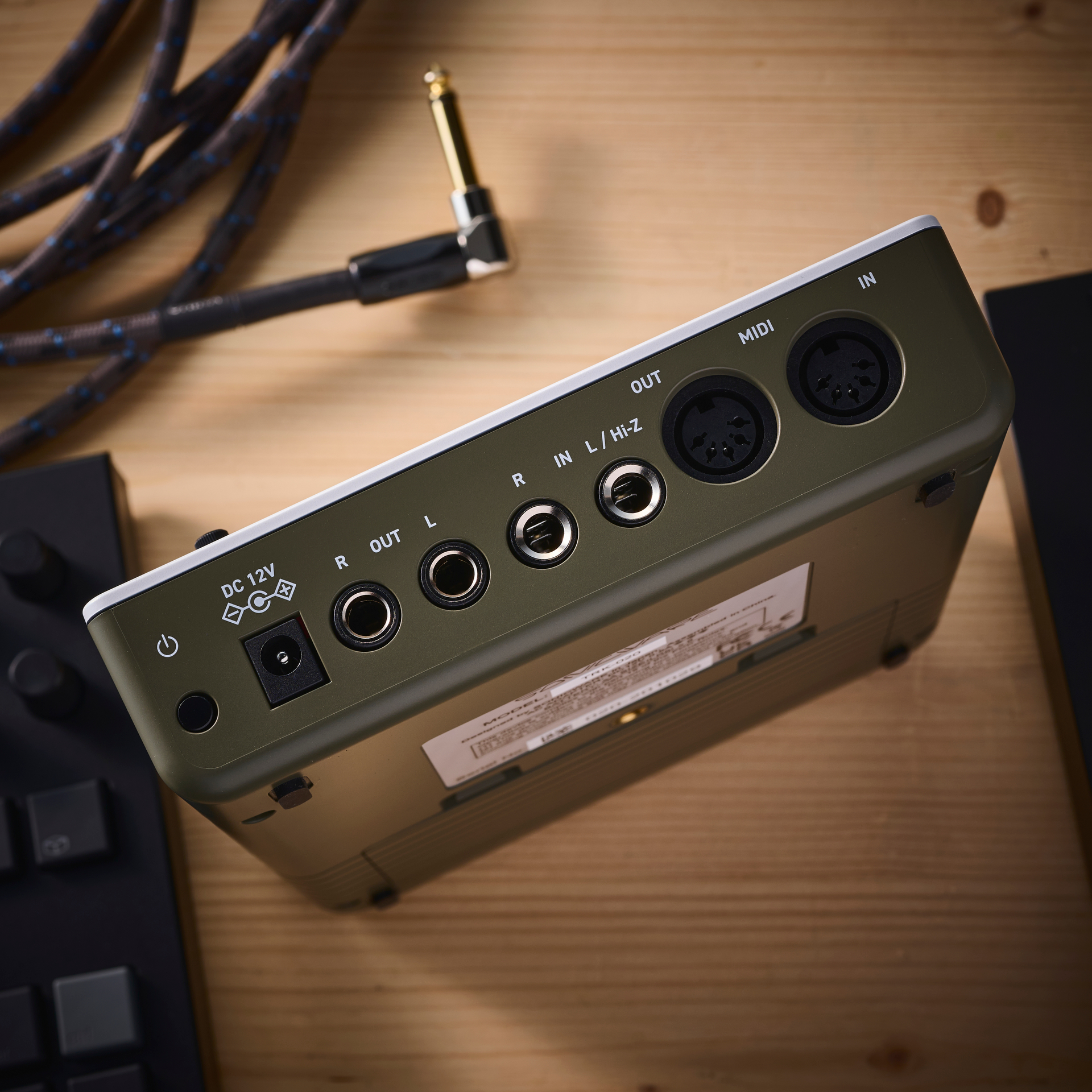
Specifications
Key features | Portable drum synth with 550 ‘4D’ sounds 8 tracks of beats and mono synth sounds based around a dual wavetable engine 64 wavetables each with up to 256 waveforms; up to 256 EFX patches Four effects blocks (two of 22 each plus reverb and master) Songs: up to 128 drum kits, up to 128 patterns, 99 patterns per song, 16 songs per project, up to 256 projects Hardware: 15 velocity-sensitive pads with RGB LEDs, 1.5 inch OLED display, built-in mono mic and 1.5W 4Ohm speaker Connections: micro USB type-B, 2 each ¼-inch line ins and outs, headphone jack (stereo 3.5mm mini), MIDI in and out, sync in and out (3.5mm mini jack), DC In, external storage card slot (standard size up to 32GB) Power: DC 12V AC adapter (supplied) or 6 AA batteries (not supplied) |
Dimensions | 147 x 175 x 46mm |
Weight | 550g |
Contact |
Andy has been writing about music production and technology for 30 years having started out on Music Technology magazine back in 1992. He has edited the magazines Future Music, Keyboard Review, MusicTech and Computer Music, which he helped launch back in 1998. He owns way too many synthesizers.
You must confirm your public display name before commenting
Please logout and then login again, you will then be prompted to enter your display name.
“She opened her mouth, and out came that orgasmic sound we know and love”: How a feat of spontaneous creativity resulted in one of Pink Floyd’s most majestic moments
“It didn’t feel like being in the room with a 17-year-old. I’d try something and she’d say, ‘You might want to reconsider that.’ And she’d be right”: Songwriter Eg White on how Adele took some “very boring chords” and turned them into an “explosive” hit
“I oversaw every element - not just the music and the lyrics and the melodies and the production, but also the merch and the fan clubs and everything”: Mike Portnoy talks about his years away from Dream Theater
